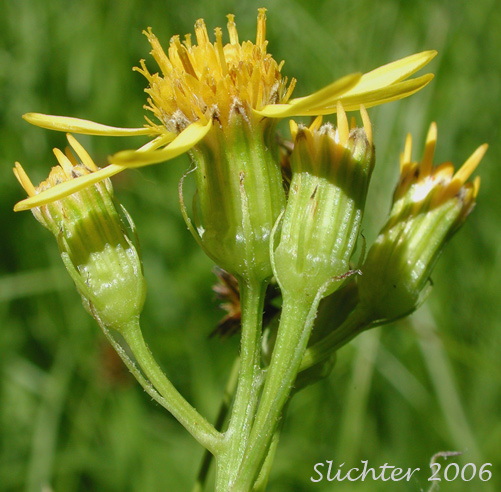 The photo at right shows a close-up of the involucral bracts of arrow-leaf butterweed. Photographed in meadows along Crofton Creek, along the Crofton Ridge Trail #73........July 16, 2006. Note that the narrow bracts are glabrous with only a few of them tipped with a dark spot.
The photo at right shows a close-up of the involucral bracts of arrow-leaf butterweed. Photographed in meadows along Crofton Creek, along the Crofton Ridge Trail #73........July 16, 2006. Note that the narrow bracts are glabrous with only a few of them tipped with a dark spot.
Arrowleaf groundsel has numerous, soft, green arrowhead shaped leaves found along the many stems that make up this plant. It ranges in size from 30-150 cm in height. The herbage is mostly smooth or glabrous. The leaves are narrowly to broadly triangular in shape, with long petioles, although the upper may become sessile. The leaf blades are coarsely toothed, and are 4-20 cm long and from 2-10 cm wide. The several to numerous flower heads are at the top of the plant in a flat-topped inflorescence. The involucre is 7-10 mm tall with 8-13 bracts. The 5-8 rays are yellow and 7-13 mm long. The disk flowers are yellow. It flowers from June to September.
Arrow-leaf groundsel is eaten by deer, elk, and sheep.
Moderate to high elevation streambanks and other wet areas in the mountains, especially those that are cool and moist.
Arrowleaf groundsel is widespread within its habitat in the west.
In the Columbia River Gorge, it is found between 100'-4300' from Crown Pt. in the west to about the Little White Salmon River in the east.